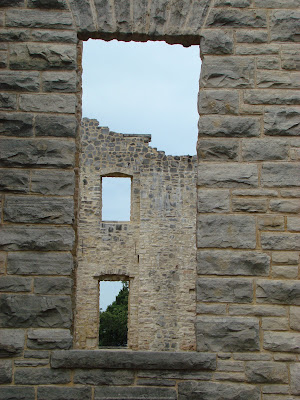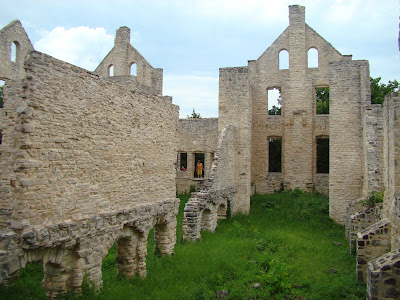
Monday, August 11, 2008
Ha Ha Tonka State Park

The Island Trail at Ha Ha Tonka State Park
 View of entrance to the cave. You must have a pre-arranged guide to take you inside.
View of entrance to the cave. You must have a pre-arranged guide to take you inside. View of the inside of the cave taken throught the bars. It looks pretty tight. There more caves located within the park as well as, commercial caves located outside the park nearby.
View of the inside of the cave taken throught the bars. It looks pretty tight. There more caves located within the park as well as, commercial caves located outside the park nearby. Wiley the Wonder dog considers spulunking.
Wiley the Wonder dog considers spulunking. A popular swim hole on the other side of the Island.
A popular swim hole on the other side of the Island. Boats moored off the swimming hole pictured above.
Boats moored off the swimming hole pictured above. Ha Ha Tonka Mist
Ha Ha Tonka Mist
The Island Trail makes a circle around the Island. We were unable to see "Balanced Rock" because the trail was closed for maintenance.
Spring Trail at Ha Ha Tonka State Park

 Picnic area and entrance to Spring Trail.
Picnic area and entrance to Spring Trail. An old grist mill stood at this location at one time. Notice the grist wheel to the right.
An old grist mill stood at this location at one time. Notice the grist wheel to the right. Another view of the Ruins a little further along the trail.
Another view of the Ruins a little further along the trail. Green pond with ferns. It appears the water was diverted along the Island to power the mill.
Green pond with ferns. It appears the water was diverted along the Island to power the mill. Channel along the Island.
Channel along the Island. The water is a steady 58 degrees all year around. Notice the mist that forms when the cool spring water meets the warmer outside air.
The water is a steady 58 degrees all year around. Notice the mist that forms when the cool spring water meets the warmer outside air. Panel explaining the spring. The spring discharges 48 million gallons of water daily.
Panel explaining the spring. The spring discharges 48 million gallons of water daily. Boardwalk the half mile walk back to the spring. This is the boardwalk seen from the Ruins.
Boardwalk the half mile walk back to the spring. This is the boardwalk seen from the Ruins. The water is a lovely turquoise color and alive with plants & fish.
The water is a lovely turquoise color and alive with plants & fish. Another view along the channel with the bluffs towering above.
Another view along the channel with the bluffs towering above. Ha Ha Tonka spring is the 12th largest spring in Missouri.
Ha Ha Tonka spring is the 12th largest spring in Missouri. A million shades of blue and green greet you along the hike to the spring.
A million shades of blue and green greet you along the hike to the spring. The spring emits from this rock face. The water appears very deep and is very clear.
The spring emits from this rock face. The water appears very deep and is very clear.
The Water Tower and Dell Rim Trail at Ha Ha Tonka State Park

 The wooden boardwalk overlooks the "Whispering Dell Sinkhole".
The wooden boardwalk overlooks the "Whispering Dell Sinkhole". A close up view of the Water Tower which was burned by vandals in 1976.
A close up view of the Water Tower which was burned by vandals in 1976. You cannot go inside the Water Tower but I was able to stick my camera inside to take an interior photo. I believe the Water Tower once had living quarters below for servants.
You cannot go inside the Water Tower but I was able to stick my camera inside to take an interior photo. I believe the Water Tower once had living quarters below for servants. Ha Ha Tonka is considered a wonderful example of "Karst" Topography. Karst topography is typified by caves, springs and sinkholes. Above is a picture of Whispering Dell Sinkhole which was formed by a partial cavern collapse.
Ha Ha Tonka is considered a wonderful example of "Karst" Topography. Karst topography is typified by caves, springs and sinkholes. Above is a picture of Whispering Dell Sinkhole which was formed by a partial cavern collapse. Signboard along boardwalk explaining the sinkhole. This Missouri State Park is well marked and very informative.
Signboard along boardwalk explaining the sinkhole. This Missouri State Park is well marked and very informative. Whispering Dell sinkhole is 150 feet deep.
Whispering Dell sinkhole is 150 feet deep. Another angle of the Water Tower.
Another angle of the Water Tower.The Missouri Archives contains an interesting old photo of the Water Tower at:
http://cdm.sos.mo.gov/cdm4/item_viewer.php?CISOROOT=/msaceg&CISOPTR=446&CISOBOX=1&REC=5
The Natural Bridge and the Colosseum Trail at Ha Ha Tonka State Park

 Looking out toward the Colosseum from under the "Bridge".
Looking out toward the Colosseum from under the "Bridge".
The bridge is listed with the Natural Arch and Bridge Society at:
Gunter's Springs Post Office at Ha Ha Tonka State Park
Robert Snyder Castle Ruins at Ha Ha Tonka State Park
 Entrance to the pathway up to the Castle Ruins. The quarter mile pathway is paved and provides splendid views of the Spring and the Lake of the Ozarks which lie 250 feet below.
Entrance to the pathway up to the Castle Ruins. The quarter mile pathway is paved and provides splendid views of the Spring and the Lake of the Ozarks which lie 250 feet below. Informational panel on the Castle Ruins with pictures of the Castle before the fire and the story of the Robert M. Snyder family who built the castle.
Informational panel on the Castle Ruins with pictures of the Castle before the fire and the story of the Robert M. Snyder family who built the castle.
 Bedroom in the castle (as seen on Missouri State Park Panel above).
Bedroom in the castle (as seen on Missouri State Park Panel above). 


 View of the Castle on fire in 1942 (as seen on the Missouri State Park Panel pictured above).
View of the Castle on fire in 1942 (as seen on the Missouri State Park Panel pictured above). View from the first "turn out" on the walk to the Castle Ruins. Below is the "Niangua Arm" of the Lake of the Ozarks. Construction of the Castle began in 1905, construction of the Lake of the Ozarks began on August 6, 1929 and wasn't completed until April 1931.
View from the first "turn out" on the walk to the Castle Ruins. Below is the "Niangua Arm" of the Lake of the Ozarks. Construction of the Castle began in 1905, construction of the Lake of the Ozarks began on August 6, 1929 and wasn't completed until April 1931. 
 The view of the boardwalk to Ha Ha Tonka spring from 250 feet above.
The view of the boardwalk to Ha Ha Tonka spring from 250 feet above. Another view of the spring from the bluff above it.
Another view of the spring from the bluff above it.
 Mr. Snyder was tragically killed in one of Missouri's first automobile accidents in 1906 and never saw his Castle completed.
Mr. Snyder was tragically killed in one of Missouri's first automobile accidents in 1906 and never saw his Castle completed. Mr. Snyder's sons eventually completed a scaled down version of the Castle.
Mr. Snyder's sons eventually completed a scaled down version of the Castle. Mr. Snyder was apparently a self-made man, becoming wealthy through the wholesale grocery business, real estate speculation, banking, utilities and oil & natural gas wells.
Mr. Snyder was apparently a self-made man, becoming wealthy through the wholesale grocery business, real estate speculation, banking, utilities and oil & natural gas wells. Mr. Snyder wanted a European style castle and even brought workmen from Europe to help build his dream retreat.
Mr. Snyder wanted a European style castle and even brought workmen from Europe to help build his dream retreat.



 The Snyder family eventually leased the house to be used as a hotel. Sparks from a chimney ignited the roof on fire. The stone stable burnt the same day.
The Snyder family eventually leased the house to be used as a hotel. Sparks from a chimney ignited the roof on fire. The stone stable burnt the same day.

 Steps leading from the front of the house to the fountain area.
Steps leading from the front of the house to the fountain area. A visitor and her dog enjoy the view.
A visitor and her dog enjoy the view. Side view of the Castle ruins.
Side view of the Castle ruins. Interior shot of the Castle.
Interior shot of the Castle. This area appears to have been the Kitchen. There is an iron rod which extends across the fireplace on which to hang pots and kettles. It seems logical the kitchen would have been in the back of the Castle though no floor plan of the Castle was available to confirm our hypothesis.
This area appears to have been the Kitchen. There is an iron rod which extends across the fireplace on which to hang pots and kettles. It seems logical the kitchen would have been in the back of the Castle though no floor plan of the Castle was available to confirm our hypothesis.
 An item in the New York Times dated January 2, 1900, stated Robert McClure Snyder was married to Sibyl MacKenzie of Boston. (I assume this was Robert McClure Snyder, Jr.) The article further noted that President McKinley and Senator Hanna sent congratulatory telegrams. Obviously, the Snyder family were Movers and Shakers of the early 20th Century.
An item in the New York Times dated January 2, 1900, stated Robert McClure Snyder was married to Sibyl MacKenzie of Boston. (I assume this was Robert McClure Snyder, Jr.) The article further noted that President McKinley and Senator Hanna sent congratulatory telegrams. Obviously, the Snyder family were Movers and Shakers of the early 20th Century. Ha Ha Tonka State Park is located about five miles Southwest of Camdenton, Missouri.
Ha Ha Tonka State Park is located about five miles Southwest of Camdenton, Missouri.  Ha Ha Tonka became a Missouri State Park in 1978.
Ha Ha Tonka became a Missouri State Park in 1978.
 View of the Castle as you approach up the pathway.
View of the Castle as you approach up the pathway. The stone for the Castle came from nearby quarries.
The stone for the Castle came from nearby quarries.
In August 2008, my husband and I visited Ha Ha Tonka State Park near Camdenton, Missouri. Prior to our visit, I attempted to find information and pictures on the park and could locate very little of either. As a result, I decided to publish some of my pictures for individuals like me who may want to learn more about the park before visiting. Feel free to post your own pictures and experiences for fellow travelers.
For more information, you may also wish to visit:

















